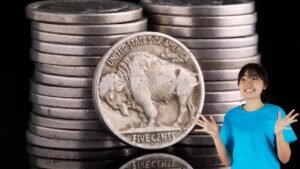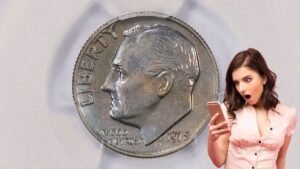Imagine finding a penny in your change that’s worth more than a luxury car. Sounds like a dream, right? But it’s real—a rare Lincoln Wheat Penny with a unique die crack sold for a staggering $575,000 at auction. The best part? Coins like this might still be hiding in your pocket or coin jar. Let’s dive into what makes these pennies so valuable, how to spot one, and why a tiny flaw could turn you into a coin-collecting hero.
What Is a Die Crack Penny?
A die crack penny is a coin with a rare minting error. During the minting process, the metal die that stamps designs onto coins can develop tiny cracks due to wear or damage. When these cracked dies are used, they leave raised lines, bumps, or blobs of metal on the coin’s surface.
To the untrained eye, these might look like imperfections. But to collectors, they’re treasures. These errors are rare because mints usually catch and discard flawed coins before they reach circulation.
Types of Die Crack Errors
Not all die cracks are the same. Some have unique names based on their appearance:
- Lightning Cracks: Jagged lines that resemble a bolt of lightning.
- Cud Errors: Large blobs of metal caused by a broken die edge.
- Extra Metal Between Letters: Odd bulges or lines that don’t belong in the coin’s design.
Each type adds a layer of uniqueness, making certain coins highly sought after.
Why Are Die Crack Pennies So Valuable?
A Lincoln Wheat Penny with a massive die crack fetched $575,000 at auction. What made it so special? Several factors:
- Unique Error: The die crack was bold and covered a large part of the coin, making it a standout.
- Excellent Condition: The coin was nearly pristine, which is rare for circulated coins.
- Historical Rarity: Lincoln Wheat Pennies, minted from 1909 to 1958, are already collector favorites. A dramatic error from this era is a goldmine.
- Mint Oversight: Major errors like this rarely slip past quality control, making them incredibly scarce.
While not every die crack penny is worth half a million, unique or dramatic errors can still fetch thousands.
How to Spot a Die Crack Penny
Ready to check your change? Here’s what to look for when hunting for a valuable die crack penny:
| What to Look For | Description |
|---|---|
| Raised Lines | Jagged or curved lines anywhere on the coin’s surface. |
| Metal Blobs (Cuds) | Thick, irregular blobs, often near the edge or rim. |
| Extra Metal | Bulges or lines between letters or design elements. |
| Lightning Cracks | Lines resembling a lightning bolt across the coin. |
Pro Tips for Spotting Errors
- Use a magnifying glass or your phone’s camera zoom to inspect coins closely.
- Focus on the edges, rims, and spaces between letters or numbers.
- Compare your coin to a standard Lincoln Wheat Penny design to spot anything unusual.
- If something looks off, don’t toss it—it could be a rare find.
Are All Die Crack Pennies Valuable?
Not every die crack penny will make you rich. Minor cracks are common and may only add a small premium. But the more dramatic or unusual the error, the higher the value. For example:
- A small, faint crack might add $10–$50 to a coin’s value.
- A large, bold crack or cud error could be worth hundreds or thousands.
- Coins in excellent condition, especially from rare years like 1914-D or 1958, can skyrocket in price.
To determine your coin’s worth, show it to a professional coin dealer or get it graded by a service like PCGS or NGC. A tiny flaw could be a game-changer.
The Lincoln Wheat Penny Legacy
Lincoln Wheat Pennies, minted from 1909 to 1958, are iconic in the coin-collecting world. Their historical significance and classic design—featuring Abraham Lincoln on the front and wheat stalks on the back—make them a favorite. Add a rare error like a die crack, and you’ve got a collector’s dream.
For instance, a 1958 Doubled Die Lincoln Cent (another rare error) sold for $224,000. These coins prove that imperfections can be incredibly valuable when they’re one-of-a-kind.
Your Next Steps to Find a Fortune
Next time you’re sorting through spare change or a jar of old coins, don’t just look for shiny pennies. Check for odd lines, bumps, or blobs. That “damaged” coin might be a rare die crack penny worth a fortune.
Here’s what to do if you find a suspicious coin:
- Inspect Closely: Use a magnifying glass to confirm the error.
- Research: Compare it to known die crack pennies online or in coin guides.
- Get It Appraised: Visit a reputable coin dealer or grading service.
- Preserve It: Store the coin in a protective holder to maintain its condition.
Why You Should Start Checking Your Change Today
The story of the $575,000 Lincoln Wheat Penny shows that life-changing treasures can hide in plain sight. A small crack or blob of metal could turn pocket change into a windfall. So, grab a magnifying glass, dig through your coins, and keep an eye out for those rare errors. Your golden ticket might be waiting.
FAQs
What is a die crack on a coin?
A die crack is a raised line or bump on a coin caused by a crack in the minting die during production.
How much is a die crack penny worth?
Values vary. Minor cracks may add $10–$50, while rare, dramatic errors can be worth thousands or even $575,000.
How do I spot a die crack penny?
Look for raised lines, blobs, or lightning-like cracks using a magnifying glass or phone camera zoom.
What is a cud error on a coin?
A cud error is a large blob of metal on a coin caused by a broken edge of the minting die.
Are Lincoln Wheat Pennies still in circulation?
Yes, Lincoln Wheat Pennies (1909–1958) can still be found in circulation, especially in old coin collections or change jars.



